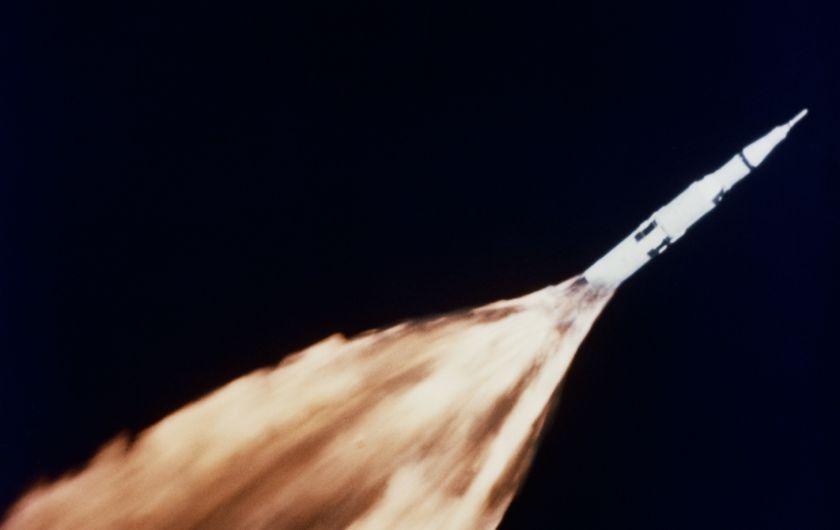
When the Saturn V rocket propelled man to the moon in July 1969, the blast from the rocket’s engines was tremendous. Marked by a dazzling display of flames and deafening noise, the monumental event gave rise to widespread claims that the acoustic force of the rocket melted concrete and ignited grass fires miles away.
New research from BYU debunks this common myth.
The study, recently published in The Journal of the Acoustical Society of America, leveraged a physics-based model to estimate the acoustic levels of Saturn V. The research team, which consisted of BYU professors Kent Gee and Grant Hart and graduate students Mark Anderson and Logan Mathews, found that the sound of the rocket launch was 203 decibels, matching up with the limited data from the 1960s.
Make no mistake, 203 decibels is loud. For context, commercial airplane engines range from 120 to 160 decibels. “One hundred and seventy decibels would be equivalent to 10 aircraft engines. Two hundred would be 10,000 engines. Every 10 decibels is an order-of-magnitude increase,” said Gee, chair of the department of physics and astronomy at BYU and co-author of the study.
Loud? Yes. Loud enough to melt concrete and start grass fires? Hardly.
Part of the misconception comes from varied reports of Saturn V’s sound levels. The researchers examined reports that suggested the sound levels were as low as 180 decibels while others reported 235 decibels – evidence that some of the historical information from the launch was based on observation, not hard data.
“When measuring decibels, you look at sound power and sound pressure,” said Anderson, who’s worked on the research team as a graduate student since fall 2021. “Sound power is like the wattage of a lightbulb; it’s the total amount of energy released by the rocket per second. Sound pressure is like the brightness of the bulb. If you stand right next to the light then you’ll see it brighter than if you’re standing further away. Similarly, sound pressure becomes less and less as you get further away.”
Reports of melting concrete or grass fires likely come from radiative heating by way of plume or debris from the launch. “Melting concrete and grass fires may have very likely happened during the Saturn V launches but attributing this to the sound of the rocket is simply beyond reasonable when you consider the physics.”
The next mission that will carry man to the moon is NASA’s Space Launch System Artemis 1, is now scheduled for September 3. The launch is anticipated to surpass Saturn V in terms of power and noise. Gee and a team of BYU students, including Anderson and Mathews, are on-site in Florida to predict Artemis' sound levels and take acoustical measurements to create models to predict future rocket noise.
“When new rockets are built, this model developed with input from BYU students will allow scientists to predict the characteristics of the noise and hopefully mitigate the effects on the payloads, as well as the communities and environment around the launch pad. We’d like a model that predicts everything from small rockets to the largest rockets,” said Hart, BYU professor of physics.
Conducting on-the-ground research for the Artemis launch epitomizes the inspiring learning opportunities afforded to BYU students – something that both Anderson and Mathews are grateful for.
“It’s been incredibly rewarding to apply skills that I have learned as a BYU student and researcher to educate the public about science in an engaging way,” said Mathews. “It’s one thing to learn and apply that learning to solving problems, but it’s an entirely different experience to help others outside your field learn something new and find excitement in science. This has helped me realize that I want to contribute beyond a specialized audience in my career and education.”
“I feel blessed to get to participate in such an exciting project and blessed to work under Dr. Kent Gee, who always strives to give us opportunities to lead, grow and mentor other students. He really cares about his students and seeks to help them develop into the best professionals they can be,” said Anderson.
More Information on This Article
News and Events














